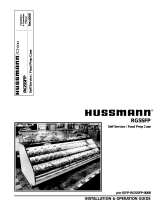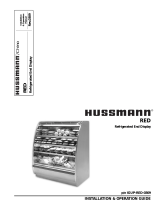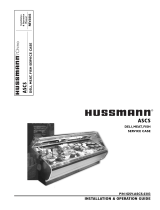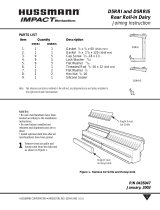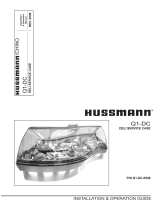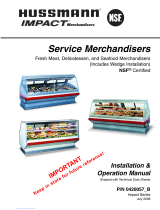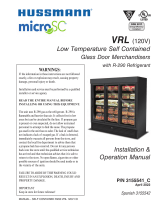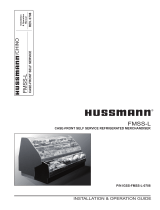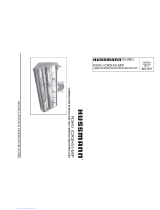Page is loading ...

/Chino
ESSS / ESS
Self Service Match ESC / ESCS
Rev.0303
Installation
& Operation
Manual
ESSS / ESS
Self Service Cases (Match ESC / ESCS)
p/n IGSS-ESSS / ESS-0303
INSTALLATION & OPERATION GUIDE

IGSS-ESS/ESSS-0303
2
/Chino
A publication of
Hussmann
®
Chino
13770 Ramona Avenue • Chino, California 91710
(909) 628-8942 FAX
(909) 590-4910
(800) 395-9229
Keep this booklet with the case at all times for future reference.
THIS BOOKLET CONTAINS INFORMATION ON:
ESSS: Refrigerated Self Service cases Matches Multideck Ser-
vice Cases
ESS: Refrigerated Self Service Case (Matches Single Deck
Service Case)
SHIPPING DAMAGE
All equipment should be thoroughly examined for ship-
ping damage before and during unloading.
This equipment has been carefully inspected at our fac-
tory and the carrier has assumed responsibility for safe
arrival. If damaged, either apparent or concealed, claim must
be made to the carrier.
APPARENT LOSS OR DAMAGE
If there is an obvious loss or damage, it must be noted on
the freight bill or express receipt and signed by the carrier’s
agent; otherwise, carrier may refuse claim. The carrier will
supply necessary claim forms.
CONCEALED LOSS OR DAMAGE
When loss or damage is not apparent until after equipment
is uncrated, a claim for concealed damage is made. Make
request in writing to carrier for inspection within 15 days,
and retain all packaging. The carrier will supply inspection
report and required claim forms.
SHORTAGES
Check your shipment for any possible shortages of mate-
rial. If a shortage should exist and is found to be the re-
sponsibility of Hussmann Chino, notify Hussmann Chino. If
such a shortage involves the carrier, notify the carrier imme-
diately, and request an inspection. Hussmann Chino will
acknowledge shortages within ten days from receipt of
equipment.
HUSSMANN CHINO PRODUCT CONTROL
The serial number and shipping date of all equipment has
been recorded in Hussmann’s files for warranty and re-
placement part purposes. All correspondence pertaining
to warranty or parts ordering must include the serial num-
ber of each piece of equipment involved, in order to pro-
vide the customer with the correct parts.
The Hussmann warranty is printed on the back
of this guide.
General Instructions
Ta b l e of Contents
General Instructions................................................. 2
Cut & Plan Views....................................................... 3
Installation ................................................................. 4
SETTING AND JOINING......................................................................................... 4
JOINT TRIM...........................................................................................................5
Plumbing.................................................................... 6
WASTE OUTLET AND P-TRAP .............................................................................. 6
Refrigeration ............................................................. 7
T-STAT LOCATION..................................................................................................7
Electrical .................................................................... 8
WIRING COLOR CODE .........................................................................................8
Joint Trim ................................................................... 9
User Information ...................................................... 9
STOCKING.............................................................................................................. 9
CASE CLEANING.................................................................................................... 10
PLEXIGLASS & ACRYLIC CARE .............................................................................. 10
PLEXIGLASS REPAIR ............................................................................................. 11
Maintenance .............................................................. 12
ELECTRICAL PRECAUTIONS................................................................................... 12
REPLACING FLUORESCENT LAMPS ....................................................................... 12
TIPS & TROUBLESHOOTING ................................................................................. 12
Specifications............................................................. 13
Condensing Unit Data.............................................. 13
Electrical Schematics ............................................... 14
Appendices ................................................................ 20
APPENDIX A. – Temperature Guidlines.............................................................. 20
APPENDIX B. – Application Recommendations.................................................. 20
APPENDIX C. – Field Recommendations............................................................ 20
APPENDIX D. – Recommendations to user ....................................................... 21

Rev.0303
3
Cut & Plan Views
ESSS
8"
CASE FRONT
8"
DRAIN AND
ELECTRICAL
MECHANICAL
STUB UP
AREA
18" X 18"
REFRIG.
MECHANICAL
STUB UP
AREA
18" X 18"
ESS (ESSS)
Plan View
Scale = 1/4"
8'-2"
(VARIABLE LENGTHS)
1" 1"
43
5
/
8
"
(49
1
/
4
" / 46
3
/
4
")
ESS
Self-Service
Scale = 1/2"
36"
5
1
/8"
43
5
/8"
31"
2
1
/8"
10
1
/2"
18"
11
1
/
8
"
34
5
/
8
"
7
1
/
4
"
11"
ESSS
Self-Service
Scale = 1/2"
36"
Light
31"
46
3
/
4
"
2
1
/
8
"
13
5
/
8
"
5
3
/
4
"
19
1
/
8
"
34
1
/
4
"
1
9
3
/
8
"
1
7
3
/
4
"
V
a
r
i
a
b
l
e
L
e
n
g
t
h
s
V
a
r
i
a
b
l
e
L
e
n
g
t
h
s
FRONT
45° OUTSIDE WEDGE
46"
49
1
/4"
10
1
/
2
"
17
3
/
4
"
17
3
/
4
"
Variable
Lengths
Variable
Lengths
FRONT
90° OUTSIDE WEDGE
1
7
3
/
4
"
1
9
3
/
8
"
V
a
r
i
a
b
l
e
L
e
n
g
t
h
s
V
a
r
i
a
b
l
e
L
e
n
g
t
h
s
FRONT
45° INSIDE WEDGE
FRONT
30° INSIDE WEDGE
1
1
1
1
/
1
6
"
1
2
1
/
1
2
"
V
a
r
ia
b
le
L
e
n
g
t
h
s
V
a
r
ia
b
le
L
e
n
g
t
h
s
1
2
1
/
2
"
1
1
1
1
/
1
6
"
V
a
r
ia
b
le
L
e
n
g
t
h
s
V
a
r
ia
b
le
L
e
n
g
t
h
s
FRONT
30° OUTSIDE WEDGE
4
6
3
/
4
"
4
3
5
/
8
"
4
6
3
/
4
"
4
3
5
/
8
"
4
6
3
/
4
"
4
3
5
/
8
"
4
6
3
/
4
"
4
3
5
/
8
"
4
6
3
/
4
"
4
3
5
/
8
"
L
R
R
L
C
L
R
L
R
L
R

IGSS-ESS/ESSS-0303
4
LOCATION
The refrigerated merchandisers have been designed for
use only in air conditioned stores where temperature and
humidity are maintained at or below 75°F and 55% rela-
tive humidity. DO NOT allow air conditioning, electric fans,
ovens, open doors or windows (etc.) to create air cur-
rents around the merchandiser, as this will impair its cor-
rect operation.
Product temperature should always be maintained at a
constant and proper temperature. This means that from
the time the product is received, through storage, prepa-
ration and display, the temperature of the product must
be controlled to maximize life of the product.
UNCRATING THE STAND
Place the fixture as close to its permanent position as
possible. Remove the top of the crate. Detach the walls
from each other and remove from the skid. Unbolt the
case from the skid. The fixture can now be lifted off the
crate skid. Lift only at base of stand!
EXTERIOR LOADING
These models have not been structurally designed to sup-
port excessive external loading. Do not walk on their
tops; This could cause serious personal injury and dam-
age to the fixture.
SETTING AND JOINING
The sectional construction of these models enable them
to be joined in line to give the effect of one continuous
display. A joint trim kit is supplied with each joint.
LEVELING AND PLACEMENT
IMPORTANT! It is imperative that cases be lev-
eled from front to back and side to side prior to
joining.
NOTE: A. To avoid removing concrete flooring, begin lineup
leveling from the highest point of the store floor.
B. When wedges are involved in a lineup, set them first.
All cases were leveled and joined prior to shipment to
insure the closest possible fit when cases are joined in the
field. When joining, use a carpenters level and shim legs
accordingly. Case must be raised correctly, under legs
where support is best, to prevent damage to case.
1. Check level of floor where cases are to be set.
Determine the highest point of the floor; cases will
be set off this point.
2. Set first case, and adjust legs over the highest part of
the floor so that case is level. Prevent damage – case
must be raised under leg or by use of 2x6 or 2x4 leg
brace. Remove side and back leg braces after case is
set.
3. Set second case as close as possible to the first case,
and level case to the first using the instructions in
step one.
JOINING - ESSS
1. Apply masking tape 1/8" in from end of case on
inside and outside rear mullion on both cases to be
joined.
2. Apply liberal bead of case joint sealant (butyl) to
dotted area shown in (Fig.2, #1) of first case. Apply
heavy amount to cover entire shaded area.
DO NOT USE PERMAGUM!
It is the contractor’s responsibility to install
case(s) according to local construction and
health codes.
3. Slide second case up to first case snugly. Then level
second case to the first case so glass front, bumper
and top are flush.
4. To compress silicone at joint, use two Jurgenson
wood clamps. Make sure case is level from front to
back and side to side on inside bulkheads at joint.
5. Attach sections together via a 2 bolts located in the
base of the case. Secure the overhead structure by
bolting the bracket, located inside behind lights.
6. Apply bead of silicone to top of bulkheads.
7. Slip on stainless steel bulkhead cap. Also apply
silicone to seam between overhead light tubes.
8. Recheck all camlocks.
JOINING - ESS
1. Using a 7mm Allen Wrench, lock in and close the
three camlock.
Installation

Rev.0303
5
Do not use cam locks to pull cases together.
2. Secure joint backer. Located behind cart bumper
suport at joints. To adjust screws holding bumper
cart to case on either side or the joint and slide
extrusion to center of joint. This piece supports the
fornt panel at the joint.
3. Apply bead of silicone to top of bulkheads.
4. Slip on stainless steel bulkhead cap. Also apply
silicone to seam between overhead light tubes.
5. Recheck all camlocks.
CORNER WEDGES
If a wedge is used in the middle of the lineup, the wedge
must be set off the highese point on the floor FIRST, with
the rest of the lineup being leveled from that point.
If an outside corner display is used, it must be mounted
and set before attaching any joint trim parts. Set the front
stainless steel bumper so it aligns with bumpers on the
two cases.
ESSS
Anchor woth bolts through bracket hjoles on legs of cases.
Install rear stianless steel plate with shelf standards to back
edge of ends with screws. Install brackest and shelves.
Next, connect applicable electrical, refrigeration, water, and
drain lines throug the access panels in the side of the stand.
After the cases have been leveled and joined, and refrig-
eration, electrical, and waste paping work completed, in-
stall the splashguards. (See instructions in the “Finishing
Touches” section of this booklet). Fasten along the top
edge, or center, with #10 x 3/4” sheet metal screws in the
pre-drilled holes.
ESS
REFRIGERATED
Inside Wedge: Line up taper pins with holes on adjoining
case. Turn camlock to lock in. Two camlocks are located at
the rear of the case behind the air discharge and behind
the lower electrical raceway panel. Bolt the front of the
wedge into the adjoining case. In refrigerated cases, the
bolt is located under the pans in the front. In the hot case,
the cases are bolted together by means of a bracket lo-
cated behind the front panel. Remove the front panel by
lifting up and then sliding out.
Outside wedge: Taper pin and camlock locations are the
same as a standard case.
DRY
Inside Wedge: Bolt the wedge into the sides of the adjoin-
ing case. Use bolts provided.
Inside Pedestal Wedge: Set wedge on the adjoining case’s
mounting brackets located at the base of the unit, and
bolt down. Drive screws provided through the sides of
the wedge (4 screws per side), accessible through the back
of the wedge.
COMMON END BETWEEN UNLIKE CASES AND HOT
CASES
Bolt end onto case using bolts provided in pre-drilled holes
behind front panel through brakcet provided and in the
rear behind the rear access panel on the bottom. Hot
cases are onlu bolted in two places. Common ends be-
tween refrigerated cases are bolted together the air dis-
charge panel. Remove air discharge panel by lifting up and
out.
Nex connect applicable electrical, refrigeration, water, and
drain lines.
JOINT TRIM
After cases have been leveled and joined, and refrigera-
tion, electrical, and wasted piping work completed, install
the splashguards. Fasten along the top edge, or center, with
#10 X 3/3" sheet metal screws.
D
O NOT SEAL JOINT T RIM T O FLOOR!
Installation (cont.)

IGSS-ESS/ESSS-0303
6
Plumbing
WASTE OUTLET AND P-TRAP
The waste outlet is located off the center of the case on
one side allowing drip piping to be run lengthwise under
the fixture.
A 1-1/2" P-trap and threaded adapter are supplied with
each fixture. The P-trap must be installed to prevent air
leakage and insect entrance into the fixture.
NOTE: PVC-DWV solvent cement is recommended.
Follow the manufacturer’s instructions.
INSTALLING CONDENSATE DRAIN
Poorly or improperly installed condensate drains can se-
riously interfere with the operation of this refrigerator,
and result in costly maintenance and product losses. Please
follow the recommendations listed below when installing
condensate drains to insure a proper installation:
1. Never use pipe for condensate drains smaller than
the nominal diameter of the pipe or P-trap supplied
with the case.
2. When connecting condensate drains, the P-trap
must be used as part of the condensate drain to
prevent air leakage or insect entrance. Store plumb-
ing system floor drains should be at least 14" off the
center of the case to allow use of the P-trap pipe
section. Never use two water seals in series in any
one line. Double P-traps in series will cause a lock
and prevent draining.
3. Always provide as much down hill slope (“fall”) as
possible; 1/8" per foot is the preferred minimum.
PVC pipe, when used, must be supported to main-
tain the 1/8" pitch and to prevent warping.
4. Avoid long runs of condensate drains. Long runs
make it impossible to provide the “fall” necessary for
good drainage.
5. Provide a suitable air break between the flood rim of
the floor drain and outlet of condensate drain. 1" is
ideal.
6. Prevent condensate drains from freezing:
a. Do not install condensate drains in contact with
non-insulated suction lines. Suction lines should be
insulated with a nonabsorbent insulation material
such as Armstrong’s Armaflex.
b. Where condensate drains are located in dead air
spaces (between refrigerators or between a
refrigerator and a wall), provide means to prevent
freezing. The water seal should be insulated to
prevent condensation.

Rev.0303
7
Refrigeration
REFRIGERANT TYPE
The standard refrigerant will be R-22 unless otherwise
specified on the customer order. Check the serial plate
on the case for information.
PIPING
The refrigerant line outlets are located under the case.
Locate first the electrical box, the outlets are then on the
same side of the case but at the opposite end. Insulate
suction lines to prevent condensation drippage.
REFRIGERATION LINES
LIQUID SUCTION
3/8" O.D. 5/8" O.D.
NOTE: The standard coil is piped at 5/8" (suction); however,
the store tie-in may vary depending on the number of
coils and the draw the case has. Depending on the case
setup, the connecting point in the store may be
5
/8",
7
/8", or 1
1
/8". Refer to the particular case you are
hooking up.
Refrigerant lines should be sized as shown on the refrig-
eration legend furnished by the store.
Install P-traps (oil traps) at the base of all suction line ver-
tical risers.
Pressure drop can rob the system of capacity. To keep the
pressure drop to a minimum, keep refrigerant line run as
short as possible, using the minimum number of elbows.
Where elbows are required, use long radius elbows only.
CONTROL SETTINGS
See the “Case Specs” section of this guidebook for the
appropriate settings for your merchandiser. Maintain these
parameters to achieve near constant product tempera-
tures. Product temperature should be measured first thing
in the morning, after having been refrigerated overnight.
For all multiplexing, defrost should be time terminated.
Loadmaster valves are not recommended. Defrost times
should be as follows: OFF CYCLE - One time daily for
110 minutes. The number of defrosts per day should never
change. The duration of the defrost cycle may be adjusted
to meet conditions present at your location.
ACCESS TO TX VALVES & DRAIN LINES
MECHANICAL - Remove product from end of case. Remove
product racks. Remove refrigeration and drain access panels
(labeled). TX valve (mechanical only) and drain are located
under each access panel at end of the case.
ELECTRONIC - The Electronic Expansion valve master and
slave cylinder(s) are located within the electrical access
panel(s).
ELECTRONIC EXPANSION VALVE (OPTIONAL)
A wide variety of electronic expansion valves and case
controllers can be utilized. Please refer to EEV and con-
troller manufacturers information sheet. Sensors for elec-
tronic expansion valves will be installed on the coil inlet,
coil outlet, and in the discharge air. (Some supermarkets
require a 4th sensor in the return air). Case controllers
will be located in the electrical raceway or under the case
THERMOSTATIC EXPANSION VALVE LOCATION
This device is located on the same side as the refrigera-
tion stub. A Sporlan balanced port expansion valve model
is furnished as standard equipment, unless otherwise speci-
fied by customer.
EXPANSION VALVE ADJUSTMENT
Expansion valves must be adjusted to fully feed the evapo-
rator. Before attempting any adjustments, make sure the
evaporator is either clear or very lightly covered with frost,
and that the fixture is within 10°F of its expected operat-
ing temperature.
MEASURING THE OPERATING SUPERHEAT
1. Determine the suction pressure with an accurate
pressure gauge at the evaporator outlet.
2. From a refrigerant pressure temperature chart,
determine the saturation temperature at the
observed suction pressure.
3. Measure the temperature of the suction gas at the
thermostatic remote bulb location.
4. Subtract the saturation temperature obtained in step
No. 2 from the temperature measured in step No. 3.
3. The difference is superheat.
5. Set the superheat for 5°F - 7°F.
T-STAT LOCATION
T-Stats are located within the electrical raceway. Refer to
diagram below.
OPTIONAL
OPTIONAL
S
L
S
B
OPTIONAL
O
DY
ESS
T-stats are located in the front electrical raceway and can
be adjusted through the knockout hole without removing
any panels. The sensing bulb is in the discharge air.
ESSS
T-stat is located in the rear electrical raceway and can be
adjusted through the knockout hole without removing any
panels. The sensing bulb is in the discharge air. If the op-
tional front electrical raceway is installed, the T-stat is lo-
cated in the font electrical raceway and can be adjusted
through the knockout hole in the front closeoff without
removing any panels.

IGSS-ESS/ESSS-0303
8
Electrical
WIRING COLOR CODE
GREEN GROUND
PURPLE ANTI-SWEAT
ORANGE LIGHTS
YELLOW RECEPTACLE
RED / BLACK T-STAT /SOLENOID230V
BLACK / WHITE T-STAT / SOLENOID 115V
BROWN FAN MOTORS
CASE MUST BE GROUNDED
NOTE: Refer to label affixed to case to determine the actual
configuration as checked in the “TYPE INSTALLED” boxes.
ELECTRICAL CIRCUIT IDENTIFICATION
Standard lighting for all models will be full length fluores-
cent lamps located within the case at the top.
The switch controlling the lights, the plug provided for
digital scale, and the thermometer are located at the rear
of the case mullion.
The receptacle that is provided on the exterior back of
these models is intended for computerized scales with a
five amp maximum load, not for large motors or other
high wattage appliances. It should be wired to a dedicated
circuit.
ELECTRICAL SERVICE RECEPTACLES
(When Applicable)
The receptacles located on the exterior of the merchan-
diser are intended for scales and lighted displays. They
are not intended nor suitable for large motors or other
external appliances.
BEFORE SERVICING
ALWAYS DISCONNECT ELECTRICAL
POWER AT THE MAIN DISCONNECT
WHEN SERVICING OR REPLACING ANY
ELECTRICAL COMPONENT.
This includes (but not limited to) Fans, Heat-
ers, Thermostats, and Lights.
FIELD WIRING & SERIAL PLATE AMPERAGE
Field Wiring must be sized for component amperes
printed on the serial plate. Actual ampere draw may be
less than specified. Field wiring from the refrigeration
control panel to the merchandisers is required for re-
frigeration thermostats. Most component amperes are
listed in the “Case Specs” section, but always check the
serial plate.
BALLAST LOCATION
Ballasts are located within the access panel that runs
the length of the rear of the case. See T-stat location
for placement, as they are in the same location.1
OPTIONAL
OPTIONAL
S
L
S
B
OPTIONAL
O
DY

Rev.0303
9
User Information
Joint Trim
ESSS Only
(ESS dows not have joint trim)
CAMLOCK
&
SEALANT
LOCATIONS
CAMLOCK
ACCESS
PANEL
APPLY SEALANT
TO SHADED AREA
JOINT BACKER
LOCATION
CAMLOCK
LOCATIONS
SEAL AROUND PIPING
ACCESS HOLES
BOLT INSIDE
WEDGES
CAMLOCK
LOCATION
STOCKING
Improper temperature and lighting will cause serious prod-
uct loss. Discoloration, dehydration and spoilage can be
controlled with proper use of the equipment and handling
of product. Product temperature should always be main-
tained at a constant and proper temperature. This means
that from the time the product is received, through stor-
age, preparation and display, the temperature of the prod-
uct must be controlled to maximize life of the product.
Hussmann cases were not designed to “heat up” or “cool
down” product—but rather to maintain an item’s proper
temperature for maximum shelf life. To achieve the pro-
tection required always:
1. Minimize processing time to avoid damaging tem-
perature rise to the product. Product should be at
proper temperature.
2. Keep the air in and around the case area free of
foreign gasses and fumes or food will rapidly dete-
riorate.
3. Maintain the display merchandisers temperature
controls as outlined in the refrigerator section of
this manual.
4. Do not place any product into these refrigerators
until all controls have been adjusted and they are
operating at the proper temperature. Allow mer-
chandiser to operate a minimum of 6 hours before
stocking with any product.
5. When stocking, never allow the product to extend
beyond the recommended load limit. Air dis-
charge and return air flue must be unob-
structed at all times to provide proper refrig-
eration.
6. There are vents located at the base of the front of
the glass, just above the front rail. These vents supply
a continuous, gentle flow of air across the front glass
which inhibits condensation. Do not place any
signs or other restrictive objects on the front
of the refrigerator that will block these vents.
7. Keep the service doors closed (when applicable).
Refrigeration performance will be seriously affected
if left open for a prolonged period of time.
8. Avoid the use of supplemental flood or spot lighting.
Display light intensity has been designed for maxi-
mum visibility and product life at the factory. The use
of higher output fluorescent lamps (H.O. and V.H.O.),
will shorten the shelf life of the product.
9. In the Deli, Meat and Fish cases, completely cover
the product each night with a clean damp cloth or
butcher paper (never use plastic, as it does not allow
for proper circulation). Make sure the cloth or paper
is in direct contact with the product.
10.Turn and rotate the meat fairly often. The blood
which gives the pink color works its way downward
with time.
11.Cold coils remove heat and moisture from the case
and deposit this as frost onto the coil. Thus, a
defrost is required. Our humidity system induces
moisture into the case and helps slow down the

IGSS-ESS/ESSS-0303
10
dehydration process. The only other moisture
within the case is that in the product itself. A single
level of meat will dry out faster than a fully loaded
case of 3–4 levels of meat.
IMPORTANT STEPS
1. Do not set temperature too cold, as this causes
product dehydration. Product Temperature:
33°–35°!
Set thermostat to cut in at 28° discharge air. Meat
holding box: 32°. Meat prep room: 55°. Meat bloom
box: 36°.
Process the meat to enter case at 40° or below.
Product deterioration is very rapid above 40°.
2. Temperature control should be by means of a T-Stat
and Suction Stop Solenoid at each case. Do not use
EPR valves, Liquid Line Solenoids or electronic
control devices of any kind, as these allow tempera-
ture swings causing dehydration and excessive
energy consumption.
3. Product should be worked and rotated on a regular
basis, not to exceed a 4-hour period.
4. At night, turn off case lights and cover the product
with a damp (not wet) cloth similar to cheese cloth
(etc.). This should be washed out in the morning and
kept in a walk-in box during the day—so that it is
cool and moist when covering the product.
5. Discharge air temperature should be approximately
26°F, with between 150-200 FPM air velocity. Do not
display product directly within the air discharge.
6. Clean Humidity system a minimum of every 90 days
for proper system operation.
CASE CLEANING
Long life and satisfactory performance of any equipment
are dependent upon the care given to it. To insure long life,
proper sanitation and minimum maintenance costs, the
refrigerator should be thoroughly cleaned frequently. SHUT
OFF FAN DURING CLEANING PROCESS. It can be un-
plugged within the case, or shut off case at the source. The
interior bottom may be cleaned with any domestic soap
or detergent based cleaners. Sanitizing solutions will not
harm the interior bottom, however, these solutions should
always be used according to the manufacturer’s directions.
It is essential to establish and regulate cleaning procedures.
This will minimize bacteria causing discoloration which
leads to degraded product appearance and signifigantly
shortening product shelf life.
Soap and hot water are not enough to kill this bacteria. A
sanitizing solution must be included with each cleaning pro-
cess to eliminate this bacteria.
1. Scrub thoroughly, cleaning all surfaces, with soap and
hot water.
2. Rinse with hot water, but do not flood.
3. Apply the sanitizing solution according to the
manufacturer’s directions.
4. Rinse thoroughly.
5. Dry completely before resuming operation.
CLEANING GLASS & MIRRORS
Only use a soft cloth and mild glass cleaner for cleaning
any glass or mirrored components. Be sure to rinse and/
or dry completely.
Never use hot water on cold glass surfaces! It
may shatter and cause serious injury! Allow glass
surfaces to warm first.
CLEANING PRECAUTIONS
WHEN CLEANING:
• DO NOT USE HIGH PRESSURE WATER HOSES
• DO NOT INTRODUCE WATER FASTER THAN WASTE OUTLET CAN DRAIN
• NEVER ON A SELF CONTAINED UNIT WITH AN EVAPORATOR FAN
• NEVER USE A CLEANING OR SANITIZING SOLUTION THAT HAS AN OIL
BASE (these will dissolve the butyl sealants) or an AMMONIA BASE
(this will corrode the copper componets of the case)
TO PRESERVE THE ATTRACTIVE FINISH:
• DO USE WATER AND A MILD DETERGENT FOR THE EXTERIOR ONLY
• DO NOT USE ABRASIVES OR STEEL WOOL SCOURING PADS
(these will mar the finish)
PLEXIGLASS & ACRYLIC CARE
CLEANING
Clean with plenty of nonabrasive soap (or detergent) and
luke warm water, using the bare hand to feel and dislodge
any caked-on dirt. A soft, grit-free cloth, sponge or cham-
ois may be used, but only as a means of carrying the water
to the plastic. Dry with a clean damp chamois or clean
soft cloth such as cotton flannel. Hard, rough cloths or
paper towels will scratch the acrylic and should not be
used.
WAXING
If after removing dirt and grease, the acrylic can be waxed
with a good grade commercial wax. This will improve the
appearance of the surface by filling in most minor scratches.
Wax should be applied in a thin even coat and brought to
a high polish by rubbing lightly with a dry clean soft cloth,
such as a cotton flannel. Excessive rubbing may cause
scratching and/or buildup an electrostatic charge which

Rev.0303
11
attracts dust and dirt to the surface. Blotting with a clean
damp cloth is recommended to remove charge.
ANTISTATIC COATINGS
For acrylic used indoors, antistatic coatings successfully
prevent the accumulation of an electrostatic charge for
periods of several months—if the surface is not washed
or wiped down with a wet cloth. Between applications of
the antistatic coatings, the parts need only be dusted with
a soft clean cloth to maintain a good appearance. In use,
liquid antistatic coatings should be applied in a very thin
even coat. If beads appear as it is applied, the coat is too
thick and the excess should be removed with another cloth.
Allow the coating to dry, then bring to a high gloss with a
soft cloth.
PLEXIGLASS REPAIR
plastic
rod
masking
tape
acrylic
cement
PARTS LIST
• 1" Plastic rod 3/16" diameter
•Acrylic Solvent Cement (IPS weldon #16, #40 or
comparable)
• Masking tape & duct tape (not supplied)
INSTRUCTIONS
Note: Cases must be leveled and set prior to joining
plexiglass. Cases were prejoined, leveled and set
at the factory to assure proper fit at the installa-
tion.
Step 1 Prepare front plexiglass for cement applica-
tion by placing masking tape, a maximum 1/16
of an inch from the seam, on both sides front
and back. Tape is to protect plexiglass from
cement spill over. Scarring will occur if cement
touches clear plexiglass.
Step 2 Sand edges with 60-80 grit paper. Parts must
fit well with no visual gap. Keep plexiglass
clean and clear of dust.
Step 3 Remove protective mask from plexiglass.
Separate front plexiglass pieces enough to
apply a bead of #16 cement within one edge
inside of seam and plastic rod area. If Weldon
#40 was supplied, refer to the instructions
below.
Step 4 Realign front plexiglass and push together
gently allowing cement to wet both surfaces.
Insert the plastic rod until flush with top of
plexiglass.
Step 5 Clamp firmly and apply tape (2" duct tape
recommended) across face of seam to secure
plexiglass from shifting while cement dries.
Allow 24 hours for glue to cure completely,
however joint will be strong enough to work
on after 2 hours.
INSTRUCTIONS FOR #40 WELD-ON CEMENT
INSTRUCTIONS:
Step 1 Bring components "A" and "B" to room
temperature.
Step 2 Add component "A" to component "B". Items
have been pre-measured at the factory.
Step 3 Stir mixture slowly and evenly to prevent air
bubbles. Mix for 1-3 minutes.
Step 4 Apply cement to one or both surfaces with
applicator. Assemble immediately!
Step 5 Apply just enough pressure to remove air
bubbles. Do not squeeze joint so hard as to
force cement out of the joint – a dry joint
may result.
Step 4 Allow to dry approximately 4 hours (at 70°).
More time may be required at lower tempera-
tures.

IGSS-ESS/ESSS-0303
12
Maintenance
ELECTRICAL PRECAUTIONS
BEFORE SERVICING – Always disconnect
electrical power at the main disconnect when
servicing or replacing any electrical component
This includes (but not limited to) Fans, Heaters,
Thermostats, and Lights.
REPLACING FLUORESCENT LAMPS
Fluorescent lamps are furnished with moisture resistant
lamp holders, shields and end caps. Whenever a florescent
lamp is replaced, be certain to reinstall the lamp shield
and end caps over the lamp. The lamps supplied are single
slim-line or bi-pin type with or without starters.
T- 5 REPLACEMENT
After replacing the T-5 bulbs, be sure to turn the light(s)
off then on again.
EVAPORATOR FANS
The evaporator fans are located at the center front of
these merchandisers directly beneath the display pans.
Should fans or blades need servicing, always replace fan blades
with the raised embossed side of the blade TOWARD THE
MOTOR.
COPPER COILS
The copper coils used in Hussmann merchandisers may
be repaired in the field. Materials are available from local
refrigeration wholesalers.
Hussmann recommends using #15 Sil-Fos for repairs.
TIPS & TROUBLESHOOTING
Before calling for service, check the following:
1. Check electrical power supply to the equipment for
connection.
2. Check fixture loading. Overstocking case will affect
its proper operation.
3. If frost is collecting on fixture and/or product, check
that Humidity Control is working properly, and that
no outside doors or windows are open—allowing
moisture to enter store.
FOR PROMPT SERVICE
When contacting the factory,
be sure to have the Case Model and Serial
Number handy. This information is on a plate
located on the case itself.

Rev.0303
13
Specifications
NOTES:These refrigerated merchandisers have been designed for use in stores where temperatures and humidity are maintained at or below 75°F and 55%RH.
Stores are responsible for setting their cases approprately in conditions which vary from the above. The number of defrosts and/or the duration may vary
for cases displaying products for which they were not designed Italicized data indicates optional equipment
ModelRefrigeration Average Disch. Air T~Stat Coil Fan Blade Qty. Defrosts Elec. Load (Amps) @ ~115 VAC
&Btu / Hr.Temperatures (°F) Speed Settings Type Size (in) & Evap. per day Fans Fans Case Case
Length Application (Ft.) (Total) Evap. Prod. Disch. (CFM) (°F) Pitch ( ° ) Fans Min. Qty. Eng. Eff. Std. Warmer Lights
ESS
4' Deli 550 3,300 20° 36° 28° 300 26° Forced Air 8" x 10° 1 40 3 0.33 0.66 0.35 0.59
Meat / Fish 650 2,600 20° 33° 26° 300 26° Forced Air 8" x 10° 1 40 3 0.33 0.60 0.35 0.59
6' Deli 550 3,300 20° 36° 28° 300 26° Forced Air 8" x 10° 2 40 3 0.66 1.20 0.52 0.59
Meat / Fish 650 3,900 20° 33° 26° 300 26° Forced Air 8" x 10° 2 40 3 0.66 1.20 0.52 0.59
8' Deli 550 4,400 20° 36° 28° 300 26° Forced Air 8" x 10° 2 40 3 0.66 1.20 0.70 0.59
Meat / Fish 650 5,300 20° 33° 26° 300 26° Forced Air 8" x 10° 2 40 3 0.66 1.20 0.70 0.59
10' Deli 550 5,500 20° 36° 28° 300 26° Forced Air 8" x 10° 3 40 3 0.99 1.80 0.87 0.59
Meat / Fish 650 6,500 20° 33° 26° 300 26° Forced Air 8" x 10° 3 40 3 0.99 1.80 0.87 0.59
12' Deli 550 6,600 20° 36° 28° 300 26° Forced Air 8" x 10° 3 40 3 0.99 1.80 1.04 0.59
Meat / Fish 650 7,800 20° 33° 26° 300 26° Forced Air 8" x 10° 3 40 3 0.99 1.80 1.04 0.59
ESS - We dg e s
45° Inside - Deli 1,650 20° 36° 28° 200 28° Forced Air 8" x 10° 1 40 3 0.33 0.60 0.26 0.61
Inside - Meat 1,950 33° 24° 26° 200 28° Forced Air 8" x 10° 1 40 3 0.33 0.60 0.26 0.61
Outside - Deli 1,650 36° 28° 28° 200 28° Forced Air 8" x 10° 1 40 3 0.33 0.60 0.09 0.61
Outside - Meat 1,950 33° 24° 26° 200 28° Forced Air 8" x 10° 1 40 3 0.33 0.60 0.09 0.61
90° Inside - Deli 3,850 36° 28° 28° 200 28° Forced Air 8" x 10° 1 40 3 0.33 0.60 0.43 0.61
Inside - Meat 4,550 33° 24° 26° 200 28° Forced Air 8" x 10° 1 40 3 0.33 0.60 0.43 0.61
Outside - Deli 3,850 36° 28° 28° 200 28° Forced Air 8" x 10° 1 40 3 0.33 0.60 0.09 0.61
Outside - Meat 4,550 33° 24° 26° 200 28° Forced Air 8" x 10° 1 40 3 0.33 0.60 0.09 0.61
Condensing Unit Data
Set (PSI) Size VoltageAmpacity
Out In (HP) (VAC)
ESS - 72" Tall
4' Deli 30 50 1/3 115 10.9
Meat / Fish 30 50 1/3 115 10.9
6' Deli 30 50 1/3 115 10.9
Meat / Fish 30 50 1/2 115 19.9
8' Deli 30 50 3/4 208 /230 8.7
Meat / Fish 30 50 3/4 208 /230 8.7
10' Deli 30 50 3/4 208 /230 8.7
Meat / Fish 30 50 1 208 /230 13.0
12' Deli 30 50 1 208 /230 13.0
Meat / Fish 30 50 1 208 /230 13.0

IGSS-ESS/ESSS-0303
14
Electrical Schematics
Light Switch
Overhead Canopy Lights
Ledge Light
(Optional)
Ballats
WH3-120-164
(125-04-0118)
Thermostat
Suction Solenoid
Duplex Receptacles
GFCI Dedicated
Line
Evaporator Fan
Cap
Case to Case Harness
Single case Pigtail
F17T8-SPX30 (2)
125-04-0101
125-04-0110
125-04-0111
125-04-0113
125-04-0113
125-04-0112
125-04-0100
(Not used)
(Not used)
(Not used)
125-04-0115
125-04-0115
125-04-0125
125-04-0126
Heater Wire
(Length of case)
Sheet ____ of ____
X
Date:
Project Title:
Drawing No.:
Drawn By:
Next Assembly:
Drawing Title:
Date:
Hussmann Corporation
13770 Ramona Avenue
Chino, CA. 91710
(909)-590-4910
Lic.#: 644406
Revisions:
No. Description:
Checked By:
By:
2' Case layout with T8 Lights
W0100007.dft
11
ASC-SS UPP Universal Power Module
Adrian Crisci
06/01/2000

Rev.0303
15
Light Switch
Front Lights (optional)
Ledge Lights
(optional)
Ballast
WH3-120-164
(125-04-0118)
Thermostat
Liquid Solenoid
Duplex Receptacles
GFCI Dedicated
Line
Ballast Extension Box
(Switched Power)
Evaporator Fans
Cap
Case to Case Harness
Single case Pigtail
F32T8-SPX30 (2)
125-04-0103
125-04-0101
125-04-0108
125-04-0110
125-04-0111
125-04-0113
125-04-0112
125-04-0113
125-04-0100
(Not used)
(Not used)
(Not used)
(Not used)
Heater Wire
(length of case)
125-04-0115
125-04-0115
Sheet ____ of ____
X
Date:
Project Title:
Drawing No.:
Drawn By:
Next Assembly:
Drawing Title:
Date:
Hussmann Corporation
13770 Ramona Avenue
Chino, CA. 91710
(909)-590-4910
Lic.#: 644406
Revisions:
No. Description:
Checked By:
By:
4' Case layout with T8 Lights
W0100008
11
ASC-SS-UPP Universal Power Module
Adrian Crisci
05.25.00
1 Added rear heater to case 07/19/99 AEC

IGSS-ESS/ESSS-0303
16
Light Switch
Front Lights
Ledge Lights
(Optional)
Ballast
WH3-120-164
(125-04-0118)
Thermostat
Liquid Solenoid
Duplex Receptacles
GFCI Dedicated
Line
Ballast Extension Box
(Switched Power)
Evaporator Fans
Cap
Case to Case Harness
Single case Pigtail
F25T8-SPX30 (2)
Plenum extension
Evaporator Fans
125-04-0104
125-04-0101
125-04-0108
125-04-0110
125-04-0111
125-04-0113
No number yet
125-04-0109
125-04-0112
125-04-0113
125-04-0113
125-04-0100
(Not used)
(Not used)
(Not used)
Heater Wire
(length of case)
125-04-0115
(Not used)
Sheet ____ of ____
X
Date:
Project Title:
Drawing No.:
Drawn By:
Next Assembly:
Drawing Title:
Date:
Hussmann Corporation
13770 Ramona Avenue
Chino, CA. 91710
(909)-590-4910
Lic.#: 644406
Revisions:
No. Description:
Checked By:
By:
6' Case layout with T8 Lights
W0100009
11
ASC-SS-UPP Universal Power Module
Adrian Crisci
05.25.2000
1 Added rear heater to case 07/19/99 AEC

Rev.0303
17
Light Switch
Front Lights
Ledge Lights
(Optional)
Ballast
WH3-120-164
(125-04-0118)
Thermostat
Liquid Solenoid
Duplex Receptacles
GFCI Dedicated
Line
Ballast Extension Box
(Switched Power)
Evaporator Fans
Cap
Case to Case Harness
Single case Pigtail
F32T8-SPX30 (2)
Plenum extension
Evaporator Fans
125-04-0105
125-04-0101
125-04-0108
125-04-0110
125-04-0111
125-04-0113
No number yet
125-04-0109
125-04-0112
125-04-0113
125-04-0113
125-04-0100
(Not used)
(Not used)
(Not used)
Heater Wire
(length of case)
125-04-0115
(Not used)
Sheet ____ of ____
X
Date:
Project Title:
Drawing No.:
Drawn By:
Next Assembly:
Drawing Title:
Date:
Hussmann Corporation
13770 Ramona Avenue
Chino, CA. 91710
(909)-590-4910
Lic.#: 644406
Revisions:
No. Description:
Checked By:
By:
8' Case layout with T8 Lights
W0100010
11
ASC-SS-UPP Universal Power Module
Adrian Crisci
05.25.2000
1 Added rear heater to case 07/19/99 AEC

IGSS-ESS/ESSS-0303
18
Light Switch
Front Lights
Ledge Lights
(Optional)
Ballasts
WH3-120-164
(125-04-0118)
Thermostat
Liquid Solenoid
F32T8-SPX30 (1)
Duplex Receptacles
GFCI Dedicated
Line
Ballast Extension Box
(Switched Power)
Evaporator Fans
Cap
Case to Case Harness
Single case Pigtail
F25T8-SPX30 (2)
Plenum extension
Evaporator Fans
Plenum extension
Evaporator Fans
125-04-0106
125-04-0101
125-04-0108
125-04-0109
125-04-0110
125-04-0112
125-04-0111
125-04-0114
125-04-0113
125-04-0109
125-04-0112
125-04-0113
125-04-0113
125-04-0100
Heater Wire
(length of case)
125-04-0115
125-04-0115
Sheet ____ of ____
X
Date:
Project Title:
Drawing No.:
Drawn By:
Next Assembly:
Drawing Title:
Date:
Hussmann Corporation
13770 Ramona Avenue
Chino, CA. 91710
(909)-590-4910
Lic.#: 644406
Revisions:
No. Description:
Checked By:
By:
10' Case layout with T8 Lights
W0100011
11
ASC-SS-UPP Universal Power Module
Adrian Crisci
05.25.2000
1 Added rear heater to case 07/19/99 AEC

Rev.0303
19
Light Switch
Front Lights
Ledge Lights
(Optional)
Ballasts
WH3-120-164
(125-04-0118)
Thermostat
Liquid Solenoid
F32T8-SPX30 (1)
Duplex Receptacles
GFCI Dedicated
Line
Ballast Extension Box
(Switched Power)
Evaporator Fans
Cap
Case to Case Harness
Single case Pigtail
F32T8-SPX30 (2)
Plenum extension
Evaporator Fans
Plenum extension
Evaporator Fans
125-04-0107
125-04-0101
125-04-0108
125-04-0109
125-04-0110
125-04-0112
125-04-0111
125-04-0114
125-04-0113
125-04-0109
125-04-0112
125-04-0113
125-04-0113
125-04-0100
Heater Wire
(length of case)
125-04-0115
125-04-0115
Sheet ____ of ____
X
Date:
Project Title:
Drawing No.:
Drawn By:
Next Assembly:
Drawing Title:
Date:
Hussmann Corporation
13770 Ramona Avenue
Chino, CA. 91710
(909)-590-4910
Lic.#: 644406
Revisions:
No. Description:
Checked By:
By:
12' Case with T8 Lights
W0100012
11
ASC-SS-UPP Universal Power Module
Adrian Crisci
05/25/99
1 Added rear heater to case 07/19/99 AEC

IGSS-ESS/ESSS-0303
20
APPENDIX A. – Temperature Guidlines
The refrigerators should be operated according to the manufacturer’s
published engineering specifications for entering air temperatures for
specific equipment applications. Table 1 shows the typical temperature
of the air entering the food zone one hour before the start of defrost
and one hour after defrost for various categories of refrigerators.
Refer to Appendix C for Field Evaluation Guidelines.
TABLE 1
Ty pe of Refrigerator Typical Entering
Air Temperature
I. OPEN DISPLAY
A. Non frozen:
1) Meat 28°F
2) Dairy/Deli 32°F
3) Produce
a. Processed 36°F
b. Unprocessed 45°F
B. Frozen 0°F
C. Ice Cream -5°F
II. CLOSED DISPLAY
A. Non frozen:
1) Meat 34°F
2) Dairy/Deli 34°F
3) Produce
a. Processed 36°F
b. Unprocessed 45°F
B. Frozen 0°F
C. Ice Cream -5°F
Single Deck Multi Deck ServiceCase Reach-In
I. Open Display Styles II. Closed Display Styles
APPENDIX B. – Application Recommendations
1.0 Temperature performance is critical for controlling bacteria
growth. Therefore, the following recommendations are included in
the standard. They are based on confirmed field experience over
many years.
1.1 The installer is responsible for following the installation instruc-
tions and recommendations provided by the manufacturer for the
installation of each individual type refrigerator.
1.2 Refrigeration piping should be sized according to the equipment
manufacturer’s recommendations and installed in accordance with
normal refrigeration practices. Refrigeration piping should be
insulated according to the manufacturer’s recommendations.
1.3 A clogged waste outlet blocks refrigeration. The installer is
responsible for the proper installation of the system which
dispenses condensate waste through an air gap into the building
indirect waste system.
1.4
The installer should perform a complete start-up evaluation prior to
the loading of food into the refrigerator, which includes such items as:
a)Initial temperature performance, Coils should be properly fed with
a refrigerant according to manufacturer’s recommendations.
b)Observation of outside influences such as drafts, radiant
heating from the ceiling and from lamps. Such influence should
be properly corrected or compensated for.
c) At the same time, checks should be made of the store dry-
bulb and wet-bulb temperatures to ascertain that they are
within the limits prescribed by the manufacturer.
d)Complete start-up procedures should include checking through
a defrost to make certain of its adequate frequency and length
without substantially exceeding the actual needs. This should
include checking the electrical or refrigerant circuits to make
sure that defrosts are correctly programmed for all the
refrigerators connected to each refrigeration system.
e) Recording instruments should be used to check performance.
APPENDIX C. – Field Recommendations
Recommendations for field evaluating the performance of retail
food refrigerators
1.0 The most consistent indicator of display refrigerator performance
is temperature of the air entering the product zone (see
Appendix A). In practical use, the precise determination of return
air temperature is extremely difficult. Readings of return air
temperatures will be variable and results will be inconsistent. The
product temperature alone is not an indicator of refrigerator
performance.
NOTE: Public Health will use the temperature of the product in
determining if the refrigerator will be allowed to display potentially
hazardous food. For the purpose of this evaluation, product
temperature above the FDA Food Code 1993 temperature for
potentially hazardous food will be the first indication that an
evaluation should be performed. It is expected that all refrigerators
will keep food at the FDA Food Code 1993 temperature for potentially
hazardous food.
1.1 The following recommendations are made for the purpose of
arriving at easily taken and understood data which, coupled with
other observations, may be used to determined whether a display
refrigerator is working as intended:
a) INSTRUMENT – A stainless steel stem-type thermometer is
recommended and it should have a dial a minimum of 1 inch
internal diameter. A test thermometer scaled only in Celsius or
dually scaled in Celsius and Fahrenheit shall be accurate to
1°C (1.8°F). Temperature measuring devices that are scaled
Appendices
/
